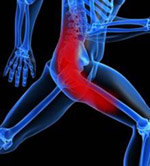 Marnie came to my Neuromuscular Therapy office near Boston with 35 years of “sciatica” type pain. Recently after kayaking, the pain had become really bad, bad enough that it was keeping her awake at night. Her symptoms were pain deep in her right side buttock with referral down her backside, into the side of her thigh, and all the way down to the top of her foot.
Marnie came to my Neuromuscular Therapy office near Boston with 35 years of “sciatica” type pain. Recently after kayaking, the pain had become really bad, bad enough that it was keeping her awake at night. Her symptoms were pain deep in her right side buttock with referral down her backside, into the side of her thigh, and all the way down to the top of her foot.
It all started back in college doing karate and carrying heavy books. Pain progressed to severe in her second year of graduate school when she felt pain in her low back and buttock. She said her “leg used to drag.” It’s better now so she walks 45 minutes a day, but she still can’t climb a flight of stairs without pain.
Marnie says she’s a happy person and has a good life, but admits that she’s intense and can push herself. She likes being active and is an avid gardener. She says she has the strength, aerobic capacity and will to exercise, but the pain prevents her from doing what she likes. It’s frustrating, so she pops some pain meds and goes out in the garden for 8 hours!
Medically she has been diagnosed with “a hole in her spine” (a birth defect) and spondylolesthesis (instability and misalignment) in the L5/S1 vertebrae of her low back. She has had cortisone shots in her back and buttock which have helped temporarily and has tried the local hospital spine center “boot camp” with no improvement.
A postural assessment of her lower body showed a hemipelvic asymmetry (bones of the hip uneven size) and a Lower Limb Length Inequality (LLLI). These structural asymmetries usually cause a tilted pelvis, one-sided low back compression and muscle tension. If left untreated, the condition can lead to Trigger Points that refer pain into the hip and buttock and down the leg.
As a Neuromuscular Therapist, what do I think about when a patient presents with “sciatica” pain symptoms? The next post is a checklist of causes that I use to help me understand what might be happening.